Category Archives: Corpus Christi Bay
Corpus Christi, TX: Extension Project on La Quinta Channel Underway
Construction is currently underway at the La Quinta Channel Extension Project in Nueces County, Texas.
Work includes deepening the channel extension and creating a beneficial use site with a scheduled completion of July 2013.
More: Dredging Today – USA: Extension Project on La Quinta Channel Underway.
Corpus Christi, Texas: APGA Files Motion in Opposition to Cheniere LNG Export Application
APGA filed a motion to intervene and protest in response to the application by Cheniere Marketing, LLC to export approximately 2.1 billion cubic feet per day (Bcf/day) of LNG from the proposed Corpus Christi Liquefaction Project to any country that the United States does not have a Free Trade Agreement (FTA) with.
To date, 20 applications have been filed at the Department of Energy (DOE) to export 28.67 Bcf/day of LNG to FTA countries. This equates to approximately 45 percent of our daily consumption. APGA members unanimously approved a resolution to oppose the export of LNG at the 2011 APGA Annual Conference.
In its filing APGA states that “proposed exports from Corpus Christi, Texas will increase domestic natural gas prices, burdening households and jeopardizing potential growth in the manufacturing sector, as well as the transition away from more environmentally damaging fossil fuels.” APGA’s comments also respond to a recently released DOE commissioned study on the macroeconomic impacts of LNG exports from the United States. Specifically, the comments state that although the study communicated that LNG exports will result in net economic benefits.
It also concluded that the higher the volume of LNG exports, the more domestic natural gas prices will rise. APGA’s filing concludes that “Cheniere’s proposal to export domestic LNG to non-FTA nations is inconsistent with the public interest because it will increase domestic natural gas and electricity prices to the detriment of all consumers, inhibit this nation’s ability to forge a path toward energy independence, and undermine sustained economic growth in key manufacturing sectors.”
USA: APGA Files Motion in Opposition to Cheniere LNG Export Application LNG World News.
Related articles
USA: Pangea LNG Seeking Approvals for Corpus Christi Project
Pangea LNG Holdings announced that it has begun the process of seeking approvals necessary to build a liquefied natural gas export facility on Corpus Christi Bay in South Texas.
Pangea has filed an application with the U.S. Department of Energy seeking authority to export up to eight million metric tons per year of liquefied natural gas to all current and future countries with which the U.S. has a Free Trade Agreement and intends to quickly file a similar application for LNG exports to any country with which the U.S. does not have a Free Trade Agreement in effect.
The project is located in the city of Ingleside on the La Quinta Ship Channel which is part of the Port of Corpus Christi. The project will be known as South Texas LNG Export.
South Texas LNG Export will be located on a portion of a 550-acre site which includes half a mile of frontage on the federally-maintained deepwater ship channel. Pangea has had the site under option since June. A separate pipeline project would connect the LNG plant to the extensive interstate and intrastate natural gas transmission pipeline network in South Texas.
Pangea LNG is an energy project and investment company involved in the development of LNG liquefaction and storage projects around the globe including an offshore floating LNG liquefaction project in the Eastern Mediterranean Sea.
John Godbold, project director for Pangea LNG, said an intensive project feasibility and preliminary design process is now underway on the South Texas project. The assessment is being conducted by CB&I, a leading international engineering, procurement and construction company.
The South Texas LNG Export project will require federal, state and local regulatory approval. The U.S. Federal Energy Regulatory Commission (FERC) is the lead agency in the permitting process. If this process moves forward on schedule the South Texas LNG terminal could be in operation by 2018.
Kathleen Eisbrenner, Pangea LNG’s chief executive officer, said, “We expect there to be several successful LNG export projects on the Texas Coast in the coming years because of the large new natural gas reserves in North America. Exporting LNG will help stabilize U.S. natural gas prices, sustain drilling and production jobs in South Texas, and stimulate investment in developing additional gas reserves.”
The South Texas project is the second LNG liquefaction project being developed by Pangea LNG companies. Levant LNG Marketing, a Pangea subsidiary, completed an extensive pre-FEED (preliminary front end engineering design), is finalizing commercial agreements and will start FEED engineering shortly on the Tamar Project which will export LNG from the Tamar and Dalit fields in the Eastern Mediterranean, 60 miles offshore from Israel.
That facility will be a permanently moored offshore floating natural gas liquefaction vessel with onboard LNG storage. The self-contained operation will be the first floating LNG export project in the Mediterranean basin. A final investment decision on the Tamar Project is expected by the second half of 2013.
USA: Pangea LNG Seeking Approvals for Corpus Christi Project LNG World News.
Corpus Christi, TX: Newly Built US Flag Vessel Makes First Call to Port Corpus Christi
Eagle Ford Shale continues to positively impact Port Corpus Christi and the U.S. economy. Yesterday, Wednesday, September 26, 2012, the M/V Pennsylvania, a newly built U.S. Flag vessel destined to move products related to Eagle Ford Shale in the region, made its first port of call to Port Corpus Christi. The tanker docked at Oil Dock 1.
The M/V Pennsylvania is one of two tankers purchased by Crowley Maritime Corporation’s petroleum and chemical transportation group as part of the Jones Act, from Aker Philadelphia Shipyard ASA (Oslo: AKPS). The Pennsylvania was delivered early this month marking Crowley’s re-entry into the Jones Act tanker market after its last tanker was retired in 2011. The tankers, capable of carrying nearly 330,000 barrels of a wide variety of petroleum products and chemicals, are destined to operate in U.S. coastal trade.
“Eagle Ford Shale has made a great impact on the port’s operations. We are glad to see more U.S. Flag vessels sailing around our coasts and we are honored to welcome the M/V Pennsylvania to the port.” Said Mike Carrell, Chairman Port of Corpus Christi.
The U.S.-flagged vessel is the 13th in the Veteran Class built at Aker. This proven design provides Crowley customers with ABS-classed vessels that have been thoroughly tested and refined for performance and reliability. With a length of 183.2 m, a breadth of 32.2 m, and a depth of 18.8 m, the tankers come in at 45,800 deadweight tons with a draft of 12.2 m. Powered by the first Tier II large-bore engines, MAN-B&W 6S50MCs, the speed of the Pennsylvania and the Florida is expected to average 14.5+ knots. In addition to being double hulled with segregated ballast systems, safety features also include water and CO2 firefighting systems, as well as a foam water spray system.
Crowley has a long history of transporting petroleum products and chemicals by tanker and articulated tug barge (ATB). Until 2011, Crowley owned and operated Jones Act product tankers that safely carried petroleum products and chemicals. Crowley has also proven itself an innovator and leader in the industry through the development of an unrivaled ATB fleet, which includes some of the newest and most sophisticated ATBs in the market. As of 2013, Crowley will own and operate 17 ATBs, which include 155,000-barrel, 185,000-barrel and 330,000-barrel capacity tank vessels. Crowley has safely and reliably operated all of these Jones Act tankers and ATBs on the U.S. Gulf, East, and West coasts under voyage and time charters with leading companies in the petroleum and chemical industries.
World Maritime News – Newly Built US Flag Vessel Makes First Call to Port Corpus Christi.
USA: Cheniere Plans Corpus Christi LNG Export Terminal
Cheniere Energy has proposed to construct a second LNG export terminal on the U.S. Gulf Coast, according to a filing this week with the federal energy regulator, Reuters reported.
The company plans to build the export terminal at Corpus Christi in Texas, originally the site for a planned liquefied natural gas import terminal with three 160,000 m3 LNG tanks.
The terminal would have the capacity to export 1.8 Bcm of gas per day and could start operations by 2017.
Corpus Christi site is located on 612 acres on the northern coast of the Corpus Christi Bay, along the La Quinta Ship Channel, a deepwater ship channel dredged to 45 feet.
Related articles
- Lithuania: Cheniere Eyes LNG Exports by 2015 (mb50.wordpress.com)
- Gas Natural Fenosa Deals with Cheniere Energy to Buy US Shale Gas Sourced LNG (mb50.wordpress.com)
- USA: Cheniere Enters into Contract with Bechtel (mb50.wordpress.com)
- ExxonMobil Eyes North American LNG Exports (mb50.wordpress.com)
- USA: Sempra Files with DOE to Export LNG from Cameron Terminal (mb50.wordpress.com)
- USA: Societe Generale Says Cheniere Can Make Sabine Pass Export Decision After Fenosa Deal (mb50.wordpress.com)
History of Corpus Christi, Texas
Map of Corpus Christi in 1887.
Corpus Christi was founded in 1839 by Colonel Henry Lawrence Kinney as Kinney’s Trading Post, or Kinney’s Ranch, a small trading post to sell supplies to a Mexican revolutionary army camped about 25 miles (40 km) west. In July 1845, U.S. troops under General Zachary Taylor set up camp there in preparation for war with Mexico, where they remained until March 1846. Then about a year later the city was named Corpus Christi and was incorporated on September 9, 1852. The Port of Corpus Christi was opened in 1926 and the Corpus Christi Naval Air Station was commissioned in 1941.
Civil War
On Feb. 23, 1861, in a statewide vote on secession, the vote in Corpus Christi was 87 for secession and 40 against, which brought the total vote in Nueces County to 164 for and 42 against. There were many Union sympathizers in the city. Some originally came from the North and some were veterans of the Mexican War.
In the second week of August, 1862, five Union warships under the command of Lt. J.W. Kittredge sailed into Corpus Christi Bay and bombarded the city. Stores and houses below the bluff made easy targets for Kittredge’s guns. The bombardment did considerable damage to the town. Many of the residents had evacuated before the battle. After it was over, people began to return to town. The Confederates, provoked by the attack, then began to take revenge by plundering the homes and property of known Union supporters.
Port of Corpus Christi
The port of Corpus Christi opened in 1926 after culminating efforts that began as early as 1848 to obtain a deep-water port. The Port of Corpus Christi currently is the sixth largest U.S. port and deepest inshore port on the Gulf of Mexico, it handles mostly oil and agricultural products. In 2005 it was ranked as the 47th largest in the world by cargo tonnage.
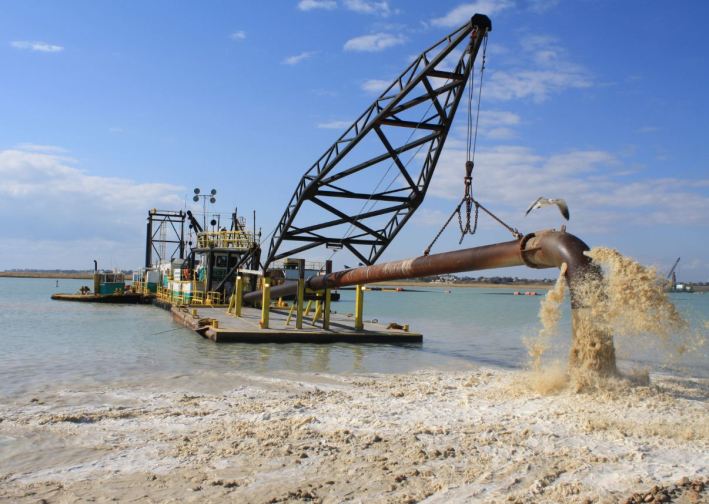




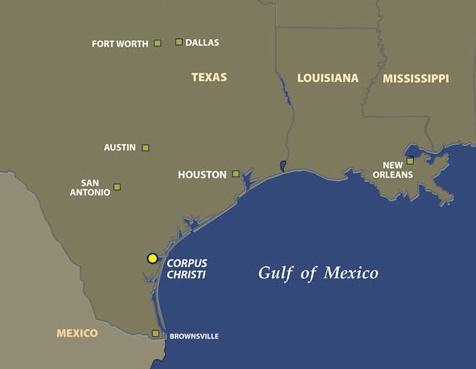






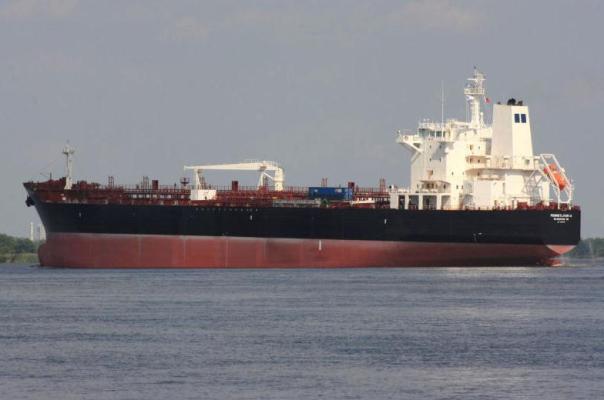










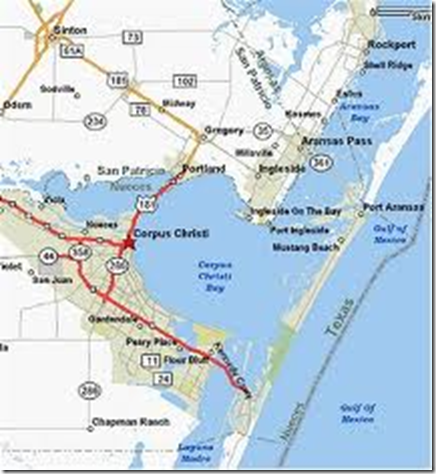
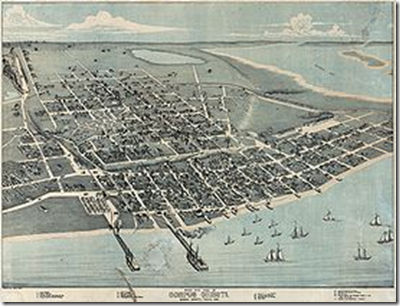
 Continents of the World
Continents of the World